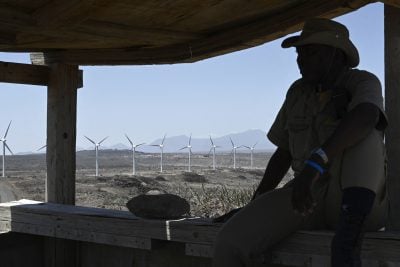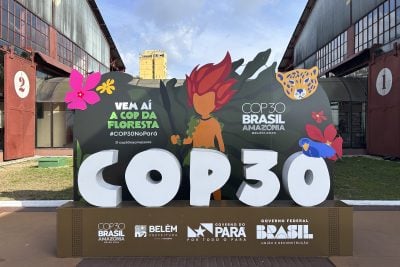The uptake for grid-scale renewable energy across Africa is uneven. Predictably, the larger economies that boast the most significant growth, as they seek to meet fast-growing demand and diversify away from fossil fuel at the same time. South Africa, Egypt and Morocco are among the leaders.
These countries also tend to have relatively sophisticated regulatory environments and financial markets, which enable Independent Power Producers to feel confident about investing
But the modular nature of solar and wind projects – and the speed with which they can be built – are also making them a more attractive proposition in countries with fewer financial resources, as these renewables allow them to expand generation through more manageable projects.
Hydropower is also firmly back in vogue in some parts of Africa, offering a relatively cheap way to produce a lot of electricity, if the reservoirs and rivers are full. Whether the effects of global warming on rainfall patterns in the region will be kind to hydropower producers remains to be seen.
In the East African Rift Valley, another option is open – Geothermal power. So far, it’s Kenya taking the lead, but others, including Uganda, are keen to get involved.
North Africa: solar rivals wind
Two of the most mature markets for renewable energy investment on the African continent, Egypt and Morocco, are also among its largest.
Morocco has led the way, focusing initially on wind. Five new wind farms have been developed under the 850 MW Integrated Wind Energy Project: Boujdour, with 300 MW, Midelt (180 MW), Jbel Lahdid (200 MW), Tiskrad (100 MW), and Tangier II (70 MW).
Boujdour is the most recent, with Enel Green Power and Nareva Holding signing a contract with the Moroccan Agency for Sustainable Energy (Masen) for the development in November 2019.
There are now 16 wind farms operating in Morocco, along with eight hydro schemes. But while these have made the biggest contributions to Morocco’s renewable energy capacity so far, solar is catching up fast. The 500 MW-plus Noor solar complex in Ouarzazate is already the world’s biggest concentrated solar power (CSP) project.
Last May, the government signed a contract with a consortium of EDF, the UAE’s Masdar and Morocco’s Green of Africa to develop the Noor Midelt scheme, which would exceed Ouarzazate in overall capacity. It includes 420 MW of solar photovoltaic solar (PV) capacity, plus 380 MW of CSP, with the former supplying power in the day and the latter in the evening.
The first phase is due to come on stream in 2022. Funding has been provided by the African Development Bank, the Clean Technology Fund, the European Commission, the European Investment Bank, the French Development Agency and the World Bank.
The developers are optimistic that the venture will prove ground-breaking. “There will be a world before, and a world after Midelt,” according to Masen Chief Executive Mustapha Bakkoury.
Masen is at various stages of pursuing tenders for other solar power projects, including a combined CSP-PV scheme in the Drâa-Tafilalet region of undetermined capacity and 200 MW spread across seven PV plants in the south and east.
Most recently, it appealed for expressions of interest in contracts to develop the first 400 MW of the Noor PV II programme, which involves eight projects in total.
Egypt’s Benban project adds capacity
In October 2019, Norway’s Scatec Solar completed the grid connection for its 390 MW Benban project near Aswan in Egypt, with partners KLP Norfund and Africa 50.
Backed by a 25-year PPA and feed-in tariffs, it is part of the Benban solar park, which has 32 concessions developed by 30 companies, including Enerray of Italy, Spain’s Acciona and EDF of France.
Generating capacity of 1.47 GW has been provided at a cost of $2bn, and it is hoped that this will be increased to 1.8 GW later. Scatec Solar’s equity investment in the project was backed by guarantees from the Multilateral Investment Guarantee Agency (MIGA), announced in March 2020, that provide cover for up to 15 years against the risks of transfer restrictions and convertibility.
Solar projects on other sites are also in the pipeline. In November, Saudi Arabia’s Acwa Power signed a PPA with the government to supply power from the 200 MW Kom Ombo PV plant, which is expected to be complete by April 2021.
Cheap solar in Tunisia
Egypt and Morocco are the only countries in North Africa to have developed significant renewable energy capacity to date, but Tunisia could be set to join them. The Tunisian Ministry of Industry held a tender last year that resulted in Scatec Solar securing contracts in December 2019 to build three solar plants with combined generating capacity of 360 MW – one of 240 MW and two of 60 MW – in Sidi Bouzid, Tataouine and Tozeur.
The winning bid of $0.0244/kWh was the lowest on record anywhere in Africa, which suggests that Tunisia could become an attractive solar market, particularly if exports to Europe can be secured. Contracts on two 100 MW projects at Gafsa and Kairouan were also awarded to a joint venture of France’s Engie and Morocco’s Nareva, and to TBEA of China respectively.
Sub-Saharan Africa: lower costs spur renewables growth
Sub-Saharan African countries, in general, have been slower to embrace renewable energy than most of the rest of the world. But falling manufacturing and operating costs, coupled with greater design efficiency, have steadily eroded the levelised cost of energy (LCOE) for wind and solar power projects, making them increasingly attractive in comparison with more established power sources. As a result, grid-scale projects are being developed in an increasing number of African countries.
Wind and solar power have the big advantage over large hydro or thermal power plants in that capacity can be added incrementally when needed and often much more quickly. These advantages seem to have driven investment in South Africa, despite the continued dominance of coal-dependent parastatal Eskom. Eight of the continent’s 10 largest solar power projects are in South Africa, most of which have been developed under the Renewable Energy Independent Power Producers Procurement Programme (REIPPPP).
The largest of these is Solar Capital’s 175 MW De Aar PV facility, which supplies Eskom with an average of 85,458 MWh/year under a 20-year PPA, plus four 100 MW CSP projects: KaXu Solar One, Xina Solar One, Ilanga 1 and Kathu Solar Park, all of which have the same long-term contract with Eskom. The first of these came on stream in 2015 and the most recent in 2019; the first two were developed by Abengoa and the last two by Sener Group.
All four are located in the Northern Cape, along with other big solar PV schemes, Jasper (96 MW), Mulilo-Sonnedix-Prieska and Kalkbult (both 86 MW). Northern Cape is about as far from the main centres of power consumption as it is possible to be in South Africa, but the gains from the province’s superior solar resources make up for the additional transmission costs.
Despite the growing attraction of solar, new wind farms are still being developed in South Africa. In March, the final turbines were installed at the 140 MW Kangnas project near Springbok in the Northern Cape, two weeks ahead of schedule and reportedly on budget. The $246m project, which has been developed by Sweden’s Mainstream Renewable Power, comprises 140 MW spread over 61 2.3 MW Siemens Gamesa turbines.
Tail wind at Lake Turkana
Most potential wind power sites in Africa are located around the coasts, particularly in the northwest and around the Red Sea. But the largest development to date is inland. The 310 MW Lake Turkana wind farm, 600km northwest of the Kenyan capital Nairobi, was officially completed last July with 365 turbines connected to the national grid. Many inland parts of Africa have limited wind resources, but Lake Turkana benefits from a wind corridor created between Mount Kulal and Mount Nyiru.
The project could soon lose its status as the region’s biggest wind farm, if China’s Sany Heavy Industries develops a 600 MW wind farm in Tanzania, as announced in December.
The 850 KW turbines deployed in the Lake Turkana project are small by current standards, in part because development took six years to come to fruition and the industry had moved on a lot in that time. Wind farms now under development are using much larger units.
A case in point are the 3.45 MW turbines used on West Africa’s first large-scale wind farm, the 158.7 MW Parc Eolien Taiba N’Diaye in Senegal, which is due to be completed this year.
New markets open up
The UAE’s Amea Power is helping to open up new African markets. In March, the Ugandan government announced that it had reached agreement with the company to develop renewable energy projects in two regions. Karamoja region will benefit from a 120 MW wind farm and 80 MW solar PV plant, while a 10 MW PV and 10 MW wind farm will be built in West Nile region in the northwest. China Energy Engineering Corporation hopes to develop another 500 MW of solar in Uganda.
Amea has also begun work on the 50 MW Blitta PV facility in Togo and has announced plans to build a 50 MW solar plant in Koulikoro region in Mali. However, it has reserved its biggest investment for Egypt, including a 500 MW wind farm at Jabal Al-Zayt.
In the longer term, offshore wind could also play a part in the African power sector as the cost of installing and operating the technology is falling rapidly. There is potential for some smaller island countries to develop offshore wind that could be used to supply their own markets, while exporting the bulk of their production to larger markets on the continent itself.
Realising geothermal potential
Where it is available, geothermal energy provides another valuable and cost-effective renewable resource for African countries. It’s also one that, unlike solar and wind, is not intermittent, as it relies on heat from below the earth to power turbines.
The East African Rift Valley is one of the world’s hotspots both in terms of geothermal potential and project development. The Olkaria V plant came on stream in Kenya in September 2019, adding 160 MW additional capacity to national baseload capacity. It was developed by Italy’s Steam and Portugal’s Gesto Energy on behalf of state utility, the Kenya Electricity Generating Company (KenGen). Other projects are being considered by IPPs, including Kenya’s own Sosian Energy and Mauritius-based Quantum.
There is geothermal potential of varying degrees right along the length of the Great Rift Valley. Ethiopia and Uganda have moved closer to developing their own geothermal plants over the past year.
In April, a consortium of Reykjavik Geothermal, Berkeley Energy, Iceland Drilling Company and InfraCo Africa signed a PPA to build the 150 MW Corbetti facility in the Ethiopian Rift Valley. Addis Ababa hopes to eventually oversee the development of 1 GW of geothermal capacity.
Future development
Although wind, solar and geothermal power projects are being developed at a faster pace in Africa than ever before, the sector is starting from a very low base. Many countries have still made little progress in attracting investment to large-scale projects.
Cash-strapped governments lack the financial resources to help fund projects themselves – and indeed will struggle to do so even more as a result of the economic impact of the Covid-19 crisis – but they could do more to encourage development. Analysts say there is scope for some governments to improve their regulatory environments and ensure that transmission utilities cooperate with IPPs, rather than protecting vested interests.
The renewables revolution offers the potential to promote greater competition in power generation, while falling costs are making wind and solar power an increasingly attractive economic option.
Mercè Labordena, senior policy advisor at SolarPower Europe, says that the growth of solar power in many African countries has been constrained by higher power prices and financing costs than in industrialised countries, which have more stable policy conditions and higher credit ratings.
Apart from low-cost financing, technology-neutral tender designs that allow for combinations of different technologies, such as solar, wind and storage, “would allow for the growth of the utility-scale solar segment in a sustainable manner”, she says.
“The combination of the different technologies would allow for not only injecting power into the electricity grid, but also for the adoption of innovative business models to provide grid services.”
Case study: Scatec Solar completes Dyason Klip 2 in South Africa
Renewables development in South Africa, like Egypt and Morocco, was originally focused on wind power. But falling costs and improving efficiency have brought solar to the fore. Solar power is a more economically viable option than wind across much of the country and so stands to make the biggest impact in efforts to allow coal-dependent South Africa to diversify its energy mix and reduce greenhouse gas emissions.
In April 2020, the 86 MW Dyason Klip 2 solar plant was completed in Northern Cape Province. The final phase of the 258 MW Upington solar power complex, it has been developed by Norwegian IPP Scatec Solar. The concessions for all three 86 MW phases at Upington were awarded in the fourth round of South Africa’s Renewable Energy Independent Power Producer Programme in 2015.
Dyason Klip 2 comprises polycrystalline PV modules and 37 inverters, with a horizontal single-axis tracker system. The contract also included the construction of access roads for both project development and operating and maintenance (O&M) access, plus transmission lines to connect it to the grid. This takes the burden off Eskom, as the grid operator, to connect it. The project is expected to produce 217 GWh a year, equivalent to the power consumption of 40,000 South African homes, while avoiding 200,000 tonnes of carbon emissions a year.
In common with other renewable energy ventures in South Africa, ownership is shared with the local community and black empowerment investors, giving local people a real stake in its success. This is a model that could be replicated elsewhere on the continent.
Scatec Solar owns a 42% stake, Norway’s development investor Norfund 18%, the community of Upington 5% and H1 Holdings, a South African black empowerment investment fund 35%.
The entire project cost $350m to develop, which is comparable with similar-scale projects elsewhere in the world. It was financed by a consortium of commercial banks and development finance institutions led by Standard Bank. As more solar projects are completed, O&M costs should fall because of improved economics of scale and growing local expertise. All output is sold by Eskom under a long-term PPA.
Scatec Solar is South Africa’s biggest solar operator with 448 MW of installed capacity. It aims to develop renewable energy projects quickly and plans to increase its installed generating capacity from 1.5 GW at present to 4.5 GW by the end of next year.
Control centre
In addition to an engineering hub, Scatec Solar has set up a global control and monitoring centre in Cape Town. Remote monitoring, digitisation and data analytics are playing an increasingly important role in the renewables sector, allowing operators to detect and sometimes fix faults remotely, while providing data to allow the performance of a specific project to be optimised, and supplying more information to improve future wind and solar farms.
Such technology has proved invaluable during the Covid-19 emergency by reducing the need for O&M teams to visit sites. At the end of March, Scatec said that the crisis had not impacted the operation of its existing projects at that point, although it had affected the construction and testing of new plants. Maintenance work continued at its operational plants, including Upington, because the power sector is regarded as critical infrastructure.
Click to see more articles from the Africa Energy Yearbook 2020
Related article
Want to continue reading? Subscribe today.
You've read all your free articles for this month! Subscribe now to enjoy full access to our content.
Digital Monthly
£8.00 / month
Receive full unlimited access to our articles, opinions, podcasts and more.
Digital Yearly
£70.00 / year
Our best value offer - save £26 and gain access to all of our digital content for an entire year!
 Sign in with Google
Sign in with Google 


